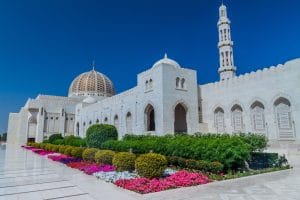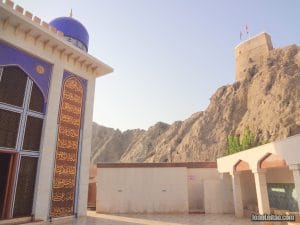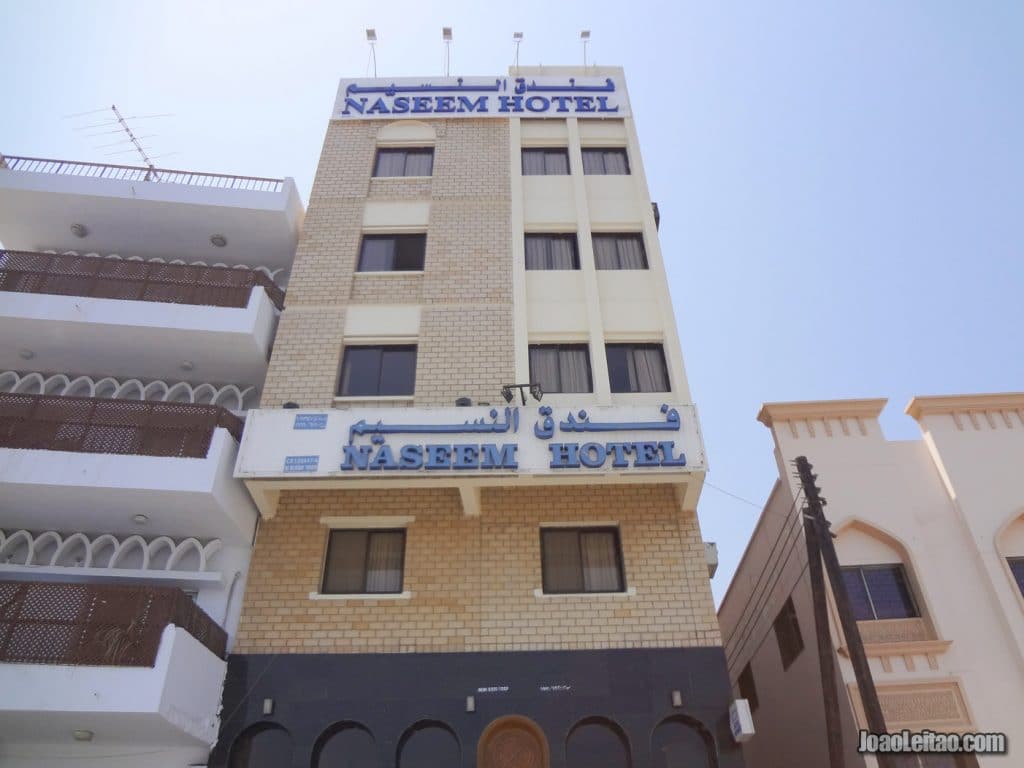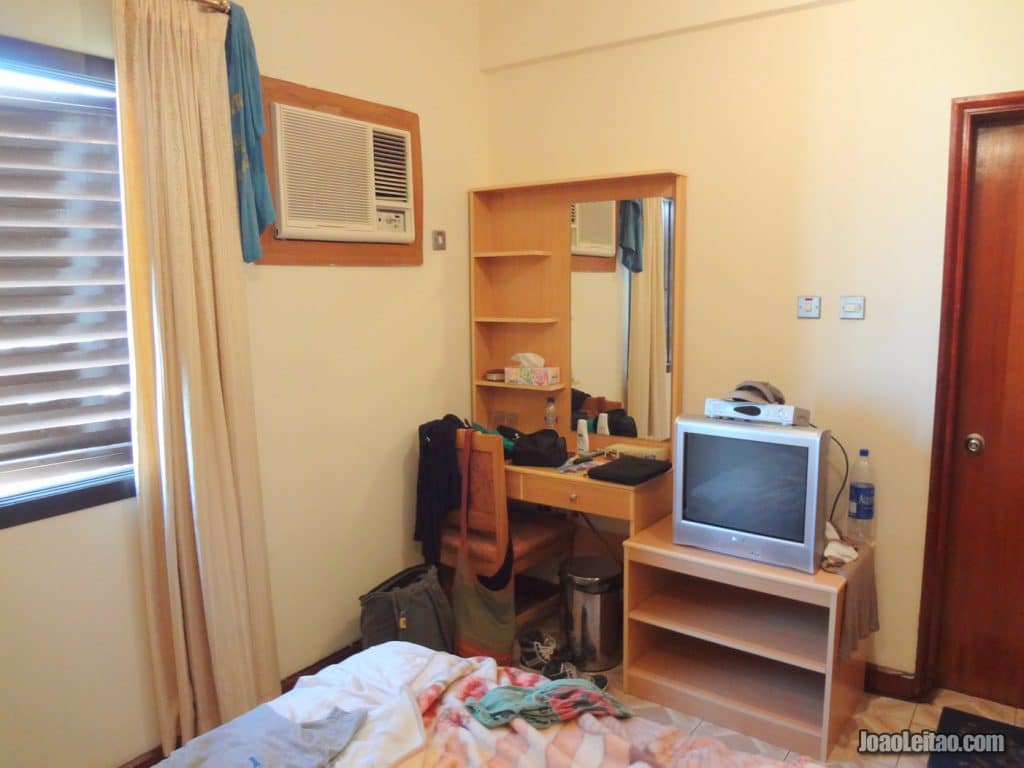Table of Contents
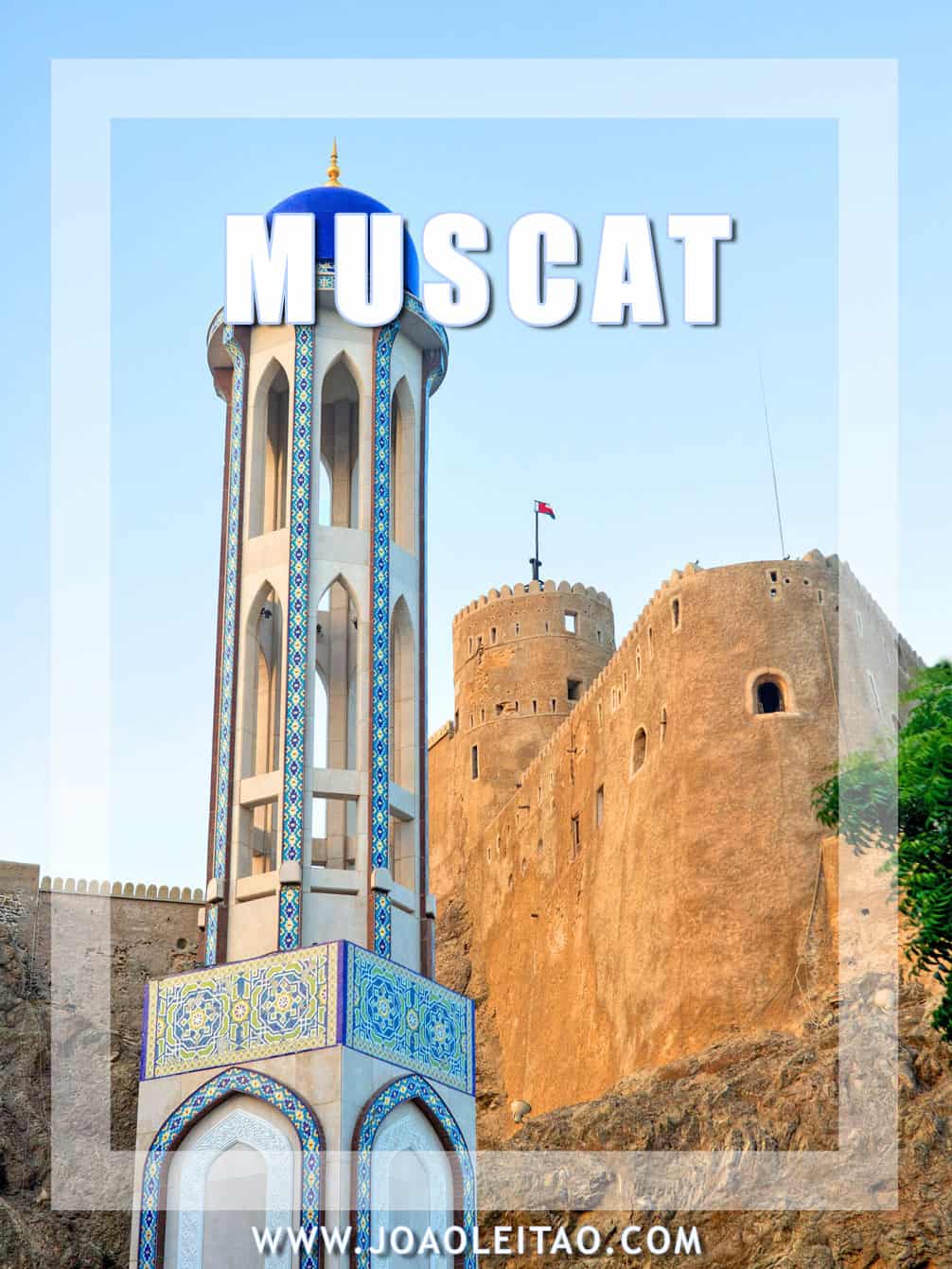
Muscat is the capital city of Oman and for most tourists the entryway into the country, their first stop before exploring the wonders of the sultanate. Visit Oman and don’t skip Muscat. If you do, you’ll be missing out on a destination worth visiting.
Thanks to its long History, Muscat has several points of interest that will keep a traveler busy, including the Sultan Qaboos Grand Mosque and the Portuguese forts.
The city has a long History that gets lost in time. It was an important port during Ancient Greece and was occupied by the Sassanids in the 3rd century.
From the 3rd century onward, under the influence of Islam, it continued to grow despite the constant territorial disputes and conflicts.
I was lucky to visit Muscat two times, and I profited to explore the city’s most famous monuments and attractions.
Check out my page: Driving in Oman: Muscat to Salalah 2-week road trip.
Muscat Top 5
1
Sultan Qaboos Grand Mosque
2
Muttrah
3
The Royal Opera House
4
Al Alam Palace
5
Corniche
Visit Muscat – What You Need to Know
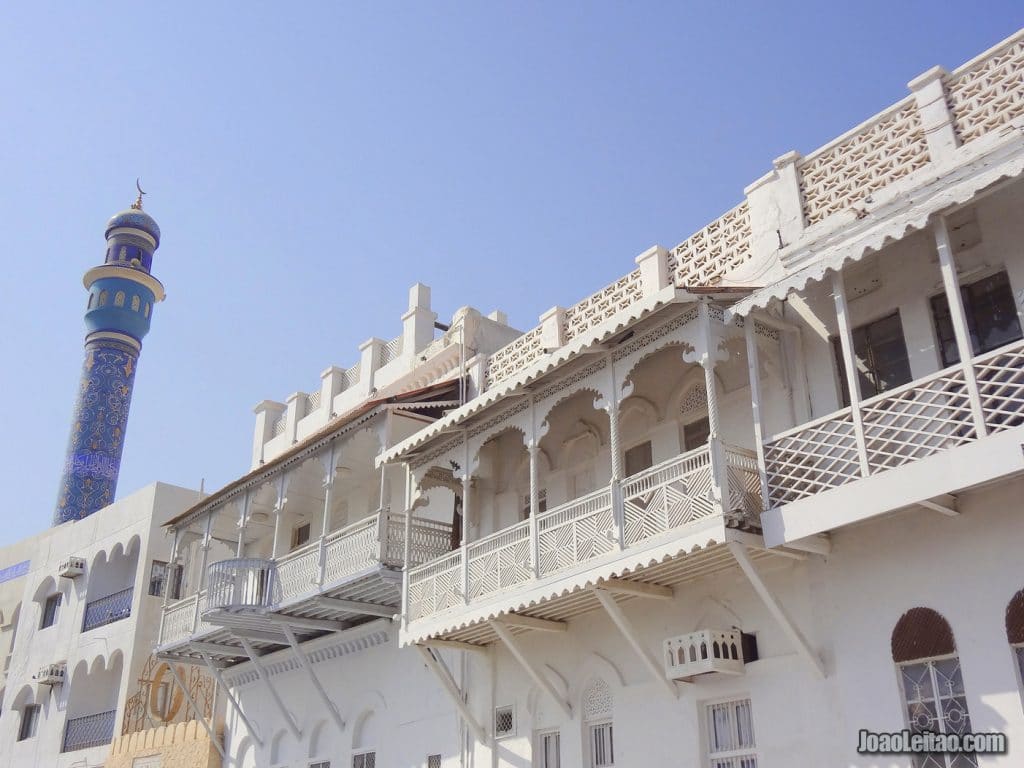
The Portuguese arrived in 1507 and retaliated the Muscat’s military attack by wiping out the city. They established themselves there shortly after and built the iconic forts you can still see today. Despite periodic attacks by Persians and Ottomans, the Portuguese stayed for about one and a half century.
In 1650, the Omani took back the city, but it only returned to its former glory in the 19th century. In the mid-20th century, it lost its capital status to Salalah, but it’s now the country’s political center.
Muscat has about one million and a half people, but the historic center is quite compact and easy to explore.
Festivals and National Holidays in Muscat
- 1 January – New Year
- 3 April – Isra and Mi’raj
- 18 November – National Day of Oman (Independence from Portugal in 1650)
- 19 November – Sultan’s Birthday
Top things to do in Muscat
- Muttrah’s Bazaar
- Great Mosque of Muscat
- Palace of the Sultan Al Qaboos
- Omani-French Heritage Museum
- Muscat Opera House
- Cornichede Muscat
- Muttrah Fish Market
- National museum
- Al Alam Palace
- Bait Al Zubair Museum
Map of attractions in Muscat
Map with the most popular attractions in Muscat
Quick travel tips to visit Muscat
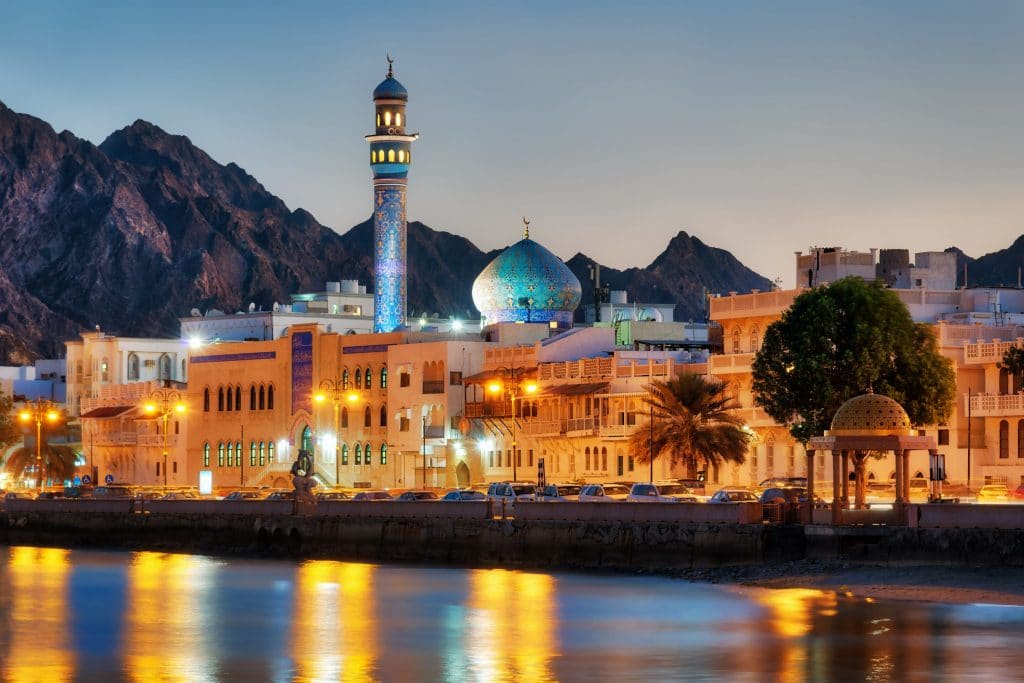
- Wake up early to be the first at monuments, museums, or other tourist attractions;
- The ferry boat Muscat-Khasab works four days a week, departing Muscat at noon on Sundays and Wednesdays and departing from Khasab on Tuesdays and Fridays;
- Explore the fabulous Muttrah Souk;
- In the evening, take a walk in the Corniche (promenade);
- Always carry a bottle of water;
- Get to know about the local climate and the seasons to know when to go to Muscat.
- To visit Muscat in the summer be prepared for high temperatures that could reach 45 Celsius degrees in the hotter hours of the day.
- There is a lot to see in Muscat in Oman, so plan your trip well to make sure you don’t miss any of the must-see sites. That way you’ll have a well-planned trip and a great vacation without skipping sites.
Best places to visit in Muscat
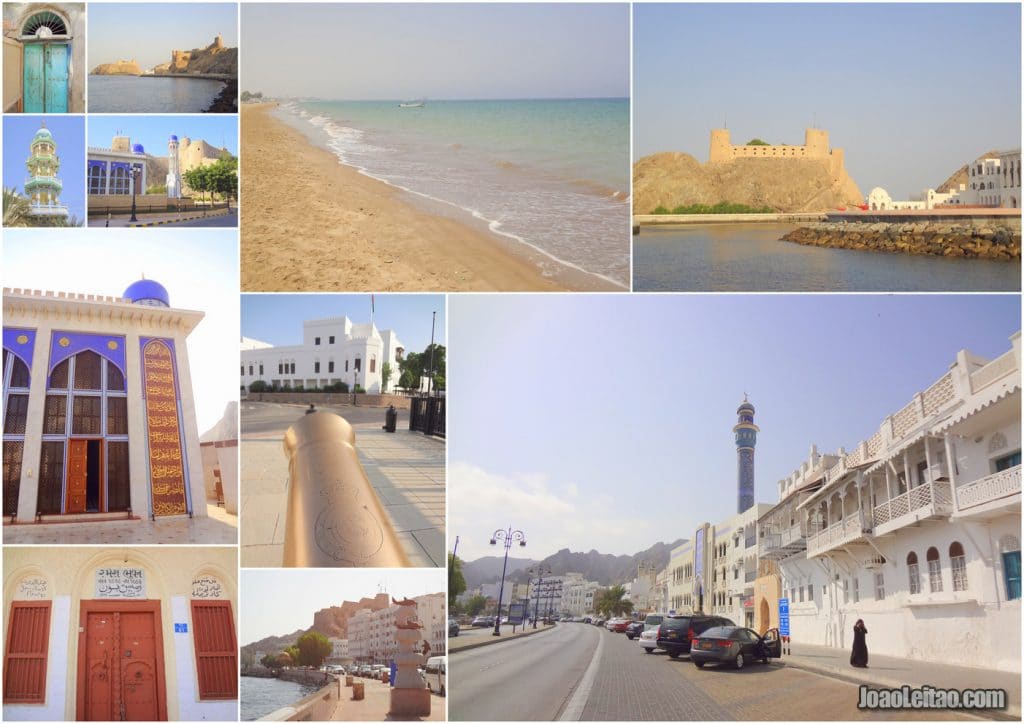
Top 12 places to visit in Muscat.
1. Sultan Qaboos Grand Mosque
It’s one of the largest mosques in Islam, and the elegance of the design and the grandeur of the building compensate for the lack of historical past.
The plans began in 1992 when the Sultan decided he wanted a Grand Mosque in the capital, but construction only started in 1995 and was finished in 2001.
The main prayer hall is square, with almost 75 meters on each side, topped by a dome 50 meters high and covered by a Persian rug 75×60 meters, which is the second largest in the world. This hall accommodates 6,500 people, but the mosque in total can accommodate 20,000 people. The building also includes a 90-meter tall minaret complemented by four smaller ones, half the height.
The mosque is relatively far from the city center, but it’s worth catching a cab to visit it. In Oman, non-Muslims are usually forbidden to enter the mosques, but the Grand Mosque is the exception.
It’s open for visits from 8:00 am to 11:00 am, except on Fridays. However, keep in mind the strict dress code to enter the mosque. If for some reason you can’t visit inside, the exterior is equally impressive and worth the trip.
2. Muttrah Corniche
Muttrah is the historic center of the Omani capital and the most visited site in the country, sometimes crawling with tourists coming off the cruise ships that dock in Muscat. Top must-sees here include, in addition to the market (souk), the Corniche. It’s a seaside promenade that attracts both locals and visitors, radiating a relaxed atmosphere, perfect for a walk to the forts that controlled the old Muscat.
It’s exceptionally beautiful at sunset when the orange light reflects on the waters of the Gulf of Oman.
From there you can see the houses used by the merchants’ families who prospered there in the 19th century, strategically built near the port of Muscat. In the background, the minarets of the many mosques around and the mountain ridge mark the cityscape.
A walk at the Corniche can include a visit to the fish market that’s open between 6:00 and 10:00 am.
3. Royal Opera House Muscat
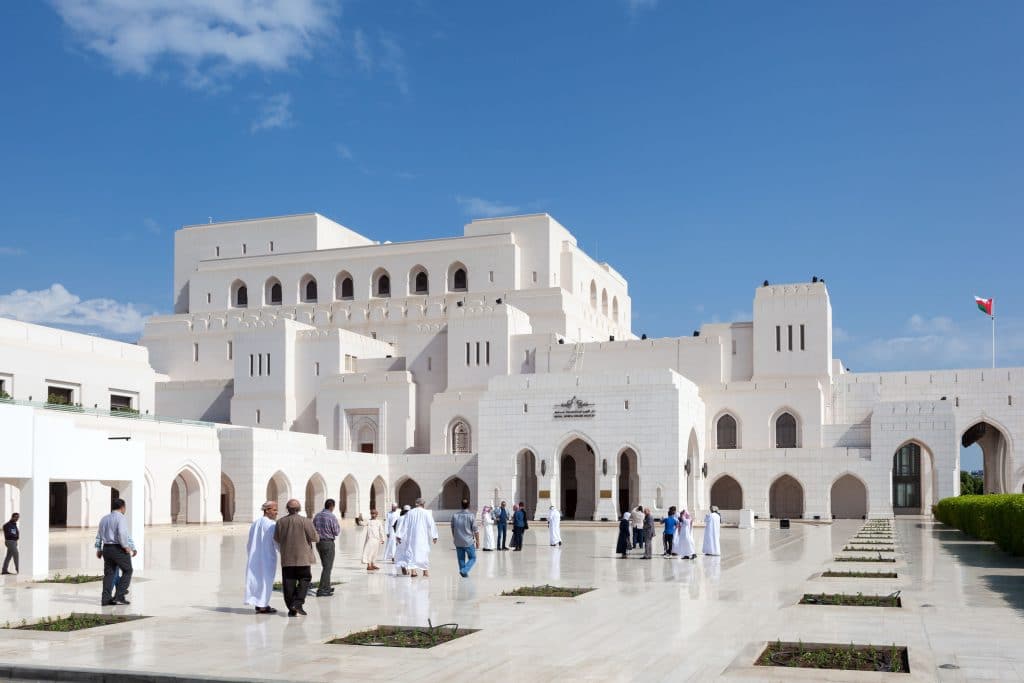
Built between 2007 and 2011 by order of Sultan Qaboos, the Royal Opera House Muscat is the main events’ venue in Oman. It has an area of 80,000 square meters and can accommodate 1,100 viewers.
It was inaugurated on 12 October 2011 with the opera Turandot and worldwide famous tenor Plácido Domingo. The first season was a success, hosting shows of high artistic and technological quality, aided by the excellent acoustics of the building. Top artists who have performed here include Andrea Bocelli, Renée Fleming, the London Philharmonic Orchestra, the American Ballet Theatre, and the Mariinsky Ballet, which presented the Swan Lake.
Even if you don’t have the chance to attend a performance, you can visit the building and the gardens. The ticket office is inside the building and they sometimes organize guided tours to the concert hall and other areas of the Royal Opera House Muscat. But ask about this first because they keep changing the schedules.
4. Al Alam Palace
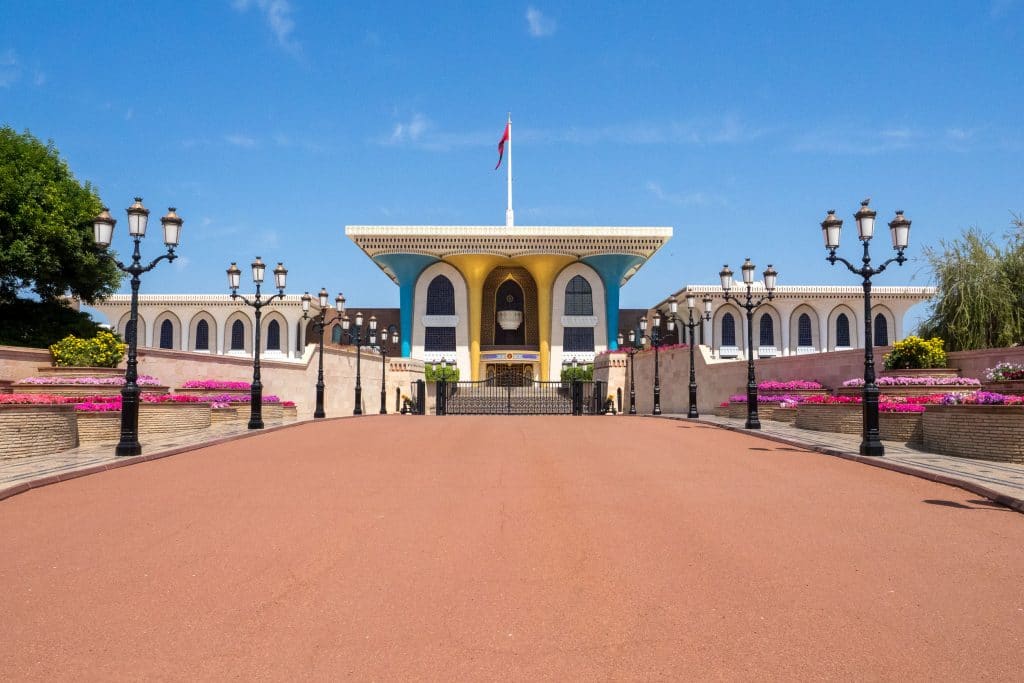
It’s the ceremonial palace of the Sultan of Oman, built in 1972 where there used to be a mansion where the previous Sultan lived.
It’s the most important of the six royal residences, although the sultan prefers to stay at El Seeb or Manah, and the most elaborate example of the contemporary Islamic architecture in Oman. The palace has two long wings, with a cubic and flat roof area in the center supported by grand columns decorated in gold and blue.
The complex is between the two old forts built by the Portuguese and you can walk there from the city center by taking the Muttrah Corniche.
Unfortunately, you can’t visit inside the palace, but tourists can appreciate the building’s architecture from its gates.
5. Al Mirani Fort
It’s one of the two forts built by the Portuguese in the 16th century, part of a defense system designed to protect the city from future attempts of reconquest. It successfully played that role for almost 150 years.
The Al Mirani Fort soon became the weakest link and was taken by the Omani in 1649, the first step to completely oust the Portuguese from the area. Allegedly, they only overtook the fort thanks to the help of an Indian merchant whose daughter the Portuguese captain wanted to marry.
While keeping his promise but postponing the wedding, little by little the Indian man emptied the fort of its gunpowder and cereal supplies and when the storage was almost empty, he sent a message to Sultan Bin Saif, who immediately attacked the fort.
Although it’s one of the iconic landmarks in Muscat, the fort, renovated in the 19th century, is not open to the public and you can only see it from the base.
6. Al Jalali Fort
Just like the Al Mirani Fort, Al Jalali was also built by the Portuguese at the end of the 16th century, then called Forte de São João (St. John Fort). It was the last stronghold of the Europeans until they were ousted in 1650.
It’s the largest of the two forts that were part of the defense system of the harbor and the city of Muscat, both to the east of the fortresses. The building’s top features are the two circular towers connected by a wall where several artillery pieces were placed.
For most of the 20th century, the fort was used as a prison. It was restored in 1983 under controversy considering how it completely altered the original design.
Today it houses the Museum of Omani Cultural Heritage, although visits are limited and you need permission from the Ministry of National Heritage and Culture.
On special occasions, the fort is used as the base for fireworks and for performances by military musicians whose bagpipes’ music fills the bay.
7. Muttrah Souk (Muttrah Market)
At the most central location in Muscat, near the Corniche and the harbor, the Muttrah souk is one of the most visited places by tourists traveling to Muscat and it’s a great first introduction to Middle Eastern markets.
The overall atmosphere is relaxed and friendly, with vendors selling their products always in the best of moods. It’s not a very large market, but it gives you a rough idea of the bustle of a souk, with a small maze of alleys where you can find a diversity of products. In addition to frankincense, a historical product for Oman, visit the sections of jewelry and handicrafts. You should haggle, but don’t expect significant discounts.
The main entrance is by the sea, where you can go to a traditional café, but the market stretches towards the east, along the gentle slope.
The Muttrah souk is also a great place to exchange currency.
8. Qurum Beach
If you spend some time in Muscat, you might enjoy relaxing for a while at this beach. It’s in the city, halfway between the international airport and the historic center, surrounded by tourist resorts, with all the pros and cons such a situation brings.
It’s a long beach with almost 8 km where you can take a nice walk on the sand or the nearby boardwalk, and where you can go for a nice meal or a refreshing drink.
It’s probably the busiest beach in Muscat and an excellent place for people watching. As for the water, the temperature is mild, it’s naturally calm, and with moderate currents, so it’s an excellent place for a swim.
9. Parliament Building
The Parliament Building in Oman is part of a group of new structures built in Muscat after 2010 and houses both the Parliament and the State Council.
It was designed with the explicit intention of becoming an iconic landmark of the city and, although you can’t visit inside, it’s worth going there just to appreciate the building’s architecture.
The mountainous backdrop highlights the details of the facades and turns it into a picture-perfect setting.
Ideally, visit the Parliament building at sunset and wait until nightfall to enjoy the magnificent lighting.
The structure has over 100,000 square meters and its top feature is the clock tower with over 65 meters in height, the tallest of its kind in the country.
10. Fish Market
The fish market takes place near the Muscat harbor in the city’s historic center. It’s only open in the morning and I recommend you visit as early as possible to feel the essence of the place.
You can start with the pier where the boats dock after spending a night at sea fishing what they’ll soon be selling at the market’s stalls. If you’re lucky, you’ll be able to witness one of those boats arriving.
Then get inside the market. It’s a new building finished in 2017 next to the old market that had been built around 1960. It has about one hundred stalls where people prepare and sell fresh fish.
Make sure you wear appropriate shoes because of the water and blood on the site.
11. Sohar
In the middle of the roundabout between the Al Bustan Palace Hotel and the Parliament, you’ll notice a strange boat. It’s the Sohar, a ship named in honor of the place with the same name where famous Omani navigator Ahmed Bin Majid was born.
It’s the replica of the ship used by Abdullah Bin Gasm, who sailed to China in the 8th century. It was built in the shipyards in Sur with palm wood and lots of ropes and without a single nail.
In 1980, British adventurer Tim Severin traveled to Guangzhou in China aboard this same ship with a crew of Omani sailors. At the time it took him eight months to complete the 11,000-kilometers long journey.
12. Muscat Gates
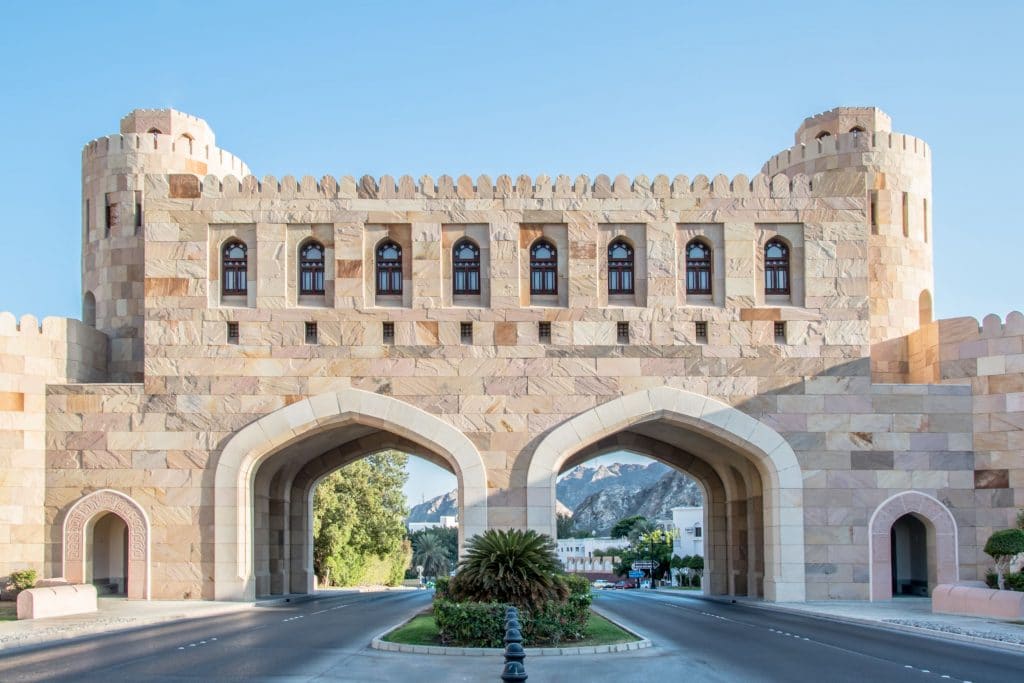
When walking the Corniche from Muttrah towards the Portuguese forts and the Parliament building, you’ll come across pristine gates. Considering how the structure looks like, you might think this is a modern construction done recently, a replica of an older style. But in fact, that is the original structure that was once part of Muscat’s defense system against robbers who tried to attack Muscat by land.
The gates were in use until the 1970s and today only those stone structures remain, completely open. You can visit a small History museum on site. One might question the appeal of the museum’s exhibition, but it’s always interesting to get inside the structure and enjoy the views.
It’s open from Sunday to Thursday, from 8:00 am to 2:00 pm.
Museums in Muscat
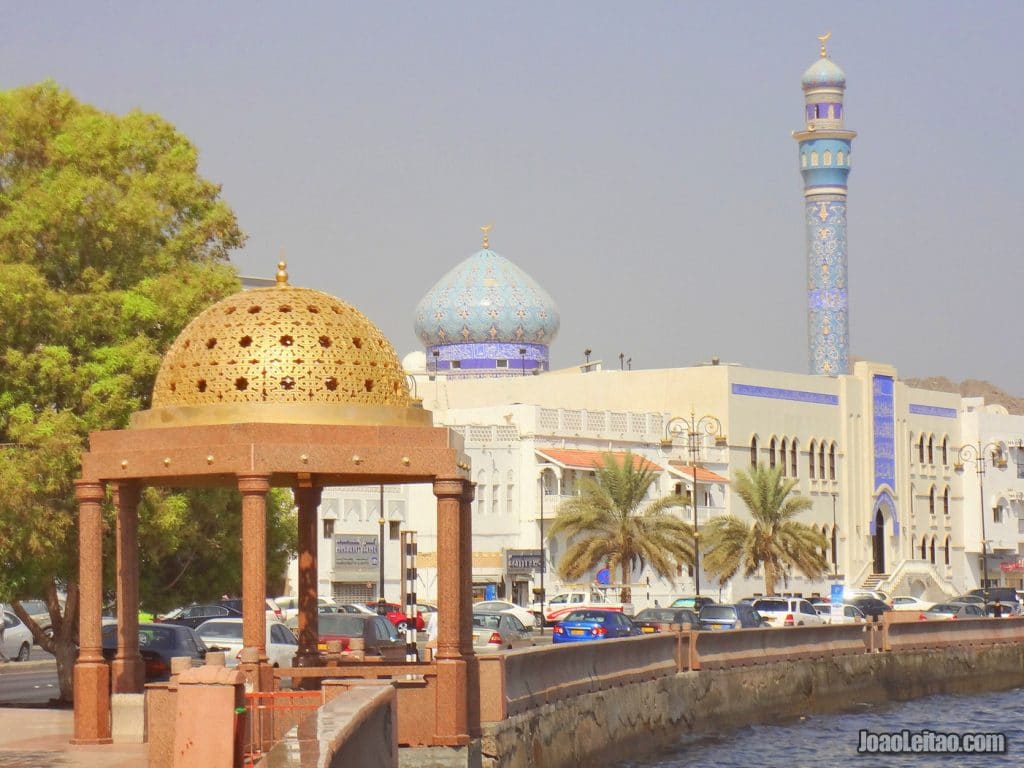
Top 7 museums in Muscat.
1. Bait Al Zubair
The Bait Al Zubair Museum is inside a restored traditional house, built initially in 1914 as the residence of the Zubair family. The collection focuses on ethnographic pieces and applied arts, including handicrafts, 19th-century photography, cartography, furniture, currency, stamps, old weapons, and traditional clothes.
This private museum opened in 1998, initially with pieces owned by the Zubair family. In recent years, it has played an important role in the Omani capital city’s cultural scene hosting temporary exhibitions and other events.
In addition to the exhibition inside the building, visit the life-size replica of an Omani village and a traditional market outside the museum. The museum also has an art gallery and a café where you can see a “wind tower,” an ancient house cooling system.
The museum in the historic center of Muscat is open every day, except Fridays, from 9:30 am to 6:00 pm.
2. National Museum
The National Museum opened in 2016 and in a building made from scratch to accommodate the collections with over 5,000 pieces, in a central area of Muscat.
The 14 main halls house the collections of The Land and the People, Maritime History, Civilization in the Making, Land of Frankincense, Arms and Armor, Aflaj Gallery, Currency, Pre-History and Ancient History, Splendors of Islam, Oman and the World, Renaissance, Intangible Heritage, and Bat, al-Khutm and al-Ayn.
It’s a well-curated place, where the exhibitions fit well with the diverse elements of lighting, area management, displays, and informative labels. To give you just an idea of how much thought went into this museum, it’s the first in the Middle East to have a whole collection with labels in Braille.
The museum is open every day from 10:00 am to 5:00 pm, but on Fridays, it’s closed in the morning. The admission ticket for foreign citizens costs 5 OR.
3. Ghalya’s Museum of Modern Art
This museum of modern art is one of the great sites of its kind in Muscat. It’s in the center of the Omani capital, not too far from the Muttrah Corniche, but a little secluded.
It’s a small space that includes the art gallery with a small collection of modern art by several Omani artists, a small exhibition of typical clothes, and a furnished traditional house. That last section includes a kitchen, a living room, the children’s and the mother’s room, the winter room, and a room dedicated to the wedding ceremonies.
The museum opened in 2011 and is housed in a group of buildings from the mid-20th century.
It’s a place that visitors can enjoy every day from 9:30 am to 6:00 pm. The admission ticket costs 1 OR.
4. Sultan’s Armed Forces Museum
The Sultan’s Armed Forces Museum is in the outskirts of Muscat, in a place called Al Falaj 4km from Muttrah. It’s the only military museum in the country.
It’s inside the Bait Al Falaj Fort built about 150 years ago as the summer house of Sultan Said bin Sultan, who ruled between 1806 and 1856. Later it became the headquarters of the Armed Forces and was turned into a museum by Sultan Qaboos. It opened in 1988.
It’s a typical military museum telling the country’s military history and showcasing the current state of the Omani Armed Forces. It’s a good exhibition scattered over two floors. The first floor is dedicated to the past of the Armed Forces while the second floor focuses on the present and the future. The largest equipment pieces are on display outside and include armored vehicles, airplanes, and small ships.
The museum is open from Sunday to Thursday, from 8:00 am to 1:30 pm, and on Saturdays from 9:00 am to noon. The admission ticket costs 1 OR and all tours are escorted by a military officer on duty.
5. Bait Al Baranda Museum
This museum opened in 2006 at a 1930s house that previously housed the American Mission and, in the 1970s, the British Council. It’s in Muttrah, near the harbor, the Corniche, and the souk (market).
The museum collection is quite diverse and includes a complete set of dinosaur bones found in the Muscat area, but it mostly focuses on History and Ethnography. It’s organized in the following sections: Muscat from the 1st century to the 18th century, conversion to Islam, Portuguese occupation, Al Bu Said Dynasty, Muscat harbor, ancient life in Muscat, earliest human settlements in Muscat, introduction to Oman History, Frankincense trade, Azd tribes migration, and Muscat in the words of cartographers and geographers.
The museum is open from Saturday to Thursday, from 9:00 am to 1:00 pm and from 4:00 to 6:00 pm. The admission ticket costs 1 OR.
6. Natural History Museum
This museum was inaugurated in 1985 and is currently housed in the building of the Ministry of Heritage and Culture. The museum is scheduled to move to a dedicated site soon, which will increase the area for exhibitions.
The museum has four main collections: Oman throughout the geological eras, the richness of animal life in Oman, the natural diversity of Oman, and the sea life in the waters of Oman.
The top highlights include the fossil collection, with pieces over 270 million years old, the embalmed animals, the whale bones, and the jaw of an ape that’s been extinct for tens of millions of years.
The museum is open from Saturday to Thursday from 9:00 am to 1:00 pm. The admission ticket costs 0.50 OR.
7. Omani French Museum
This museum opened at a fascinating building over 170 years old, built by Sultan Assayed, and that once housed the French Consulate in Muscat. The collection focuses on the timeline of diplomatic relations between France and Oman, but visiting the museum is a unique opportunity to see the inside of a building with a lot of History and where you can feel the colonial atmosphere of 19th century Muscat.
The exhibition showcases old documents and photographs of a gone by era, traditional clothes, furniture, jewelry, and ship models.
The museum is open Monday to Thursday, from 8:00 am to 2:00 pm. The admission ticket for foreign tourists costs 2 OR.
Where to Stay in Muscat
Hotel Naseem
If you’re looking for a hotel close to the Muscat harbor, Hotel Naseem is the most affordable with reasonable amenities and cleanliness.
The Hotel Naseem in Muscat is in the Muttrah area, next to the roundabout that connects the Al Bahri street to the Al Mina street, right before the road that leads to the harbor gate. The street of the hotel faces the ocean (at the so-called Corniche) and has fantastic views. In fact, the whole street is one of the most photographed places in Muscat after the castles in the city further ahead.
Price rates at this hotel in Muscat range from 22 Rials for a double room to 18 Rials for a single room. The man at the reception is very friendly and helpful. Some rooms face the ocean, so there’s no harm in asking for a “room with a view, please.” The rooms are equipped with private bathroom, TV, and air conditioning. There’s a small parking lot in front of the hotel.
Read my page: Visit Oman • 25 amazing places & top things to do.

